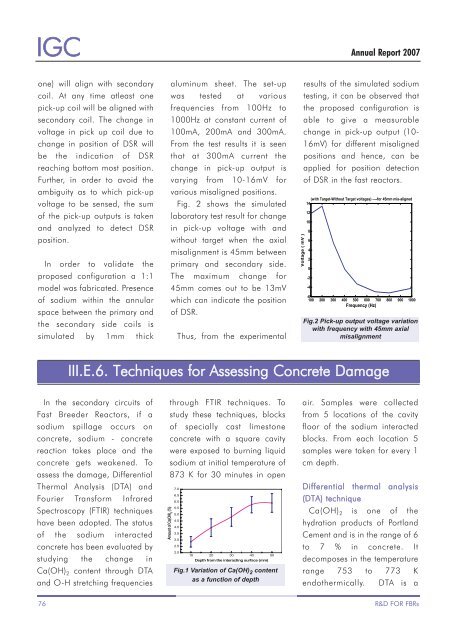IGCAR : Annual Report - Indira Gandhi Centre for Atomic Research
IGCAR : Annual Report - Indira Gandhi Centre for Atomic Research
IGCAR : Annual Report - Indira Gandhi Centre for Atomic Research
You also want an ePaper? Increase the reach of your titles
YUMPU automatically turns print PDFs into web optimized ePapers that Google loves.
IGC<br />
<strong>Annual</strong> <strong>Report</strong> 2007<br />
one) will align with secondary<br />
coil. At any time atleast one<br />
pick-up coil will be aligned with<br />
secondary coil. The change in<br />
voltage in pick up coil due to<br />
change in position of DSR will<br />
be the indication of DSR<br />
reaching bottom most position.<br />
Further, in order to avoid the<br />
ambiguity as to which pick-up<br />
voltage to be sensed, the sum<br />
of the pick-up outputs is taken<br />
and analyzed to detect DSR<br />
position.<br />
In order to validate the<br />
proposed configuration a 1:1<br />
model was fabricated. Presence<br />
of sodium within the annular<br />
space between the primary and<br />
the secondary side coils is<br />
simulated by 1mm thick<br />
aluminum sheet. The set-up<br />
was tested at various<br />
frequencies from 100Hz to<br />
1000Hz at constant current of<br />
100mA, 200mA and 300mA.<br />
From the test results it is seen<br />
that at 300mA current the<br />
change in pick-up output is<br />
varying from 10-16mV <strong>for</strong><br />
various misaligned positions.<br />
Fig. 2 shows the simulated<br />
laboratory test result <strong>for</strong> change<br />
in pick-up voltage with and<br />
without target when the axial<br />
misalignment is 45mm between<br />
primary and secondary side.<br />
The maximum change <strong>for</strong><br />
45mm comes out to be 13mV<br />
which can indicate the position<br />
of DSR.<br />
Thus, from the experimental<br />
results of the simulated sodium<br />
testing, it can be observed that<br />
the proposed configuration is<br />
able to give a measurable<br />
change in pick-up output (10-<br />
16mV) <strong>for</strong> different misaligned<br />
positions and hence, can be<br />
applied <strong>for</strong> position detection<br />
of DSR in the fast reactors.<br />
Fig.2 Pick-up output voltage variation<br />
with frequency with 45mm axial<br />
misalignment<br />
III.E.6. Techniques <strong>for</strong> Assessing Concrete Damage<br />
In the secondary circuits of<br />
Fast Breeder Reactors, if a<br />
sodium spillage occurs on<br />
concrete, sodium - concrete<br />
reaction takes place and the<br />
concrete gets weakened. To<br />
assess the damage, Differential<br />
Thermal Analysis (DTA) and<br />
Fourier Trans<strong>for</strong>m Infrared<br />
Spectroscopy (FTIR) techniques<br />
have been adopted. The status<br />
of the sodium interacted<br />
concrete has been evaluated by<br />
studying the change in<br />
Ca(OH) 2 content through DTA<br />
and O-H stretching frequencies<br />
through FTIR techniques. To<br />
study these techniques, blocks<br />
of specially cast limestone<br />
concrete with a square cavity<br />
were exposed to burning liquid<br />
sodium at initial temperature of<br />
873 K <strong>for</strong> 30 minutes in open<br />
Amount of Ca(OH) 2<br />
(%)<br />
7.0<br />
6.5<br />
6.0<br />
5.5<br />
5.0<br />
4.5<br />
4.0<br />
3.5<br />
3.0<br />
2.5<br />
2.0<br />
10 20 30 40 50<br />
Depth from the interacting surface (mm)<br />
Fig.1 Variation of Ca(OH) 2 content<br />
as a function of depth<br />
air. Samples were collected<br />
from 5 locations of the cavity<br />
floor of the sodium interacted<br />
blocks. From each location 5<br />
samples were taken <strong>for</strong> every 1<br />
cm depth.<br />
Differential thermal analysis<br />
(DTA) technique<br />
Ca(OH) 2 is one of the<br />
hydration products of Portland<br />
Cement and is in the range of 6<br />
to 7 % in concrete. It<br />
decomposes in the temperature<br />
range 753 to 773 K<br />
endothermically. DTA is a<br />
76 R&D FOR FBRs

















